Health Centre Incinerator Design: Environmental Impact and Proposal
VerifiedAdded on 2021/06/16
|12
|2757
|106
Report
AI Summary
This report proposes a comprehensive design for a health centre incinerator aimed at minimizing contamination risks to patients, the public, and healthcare workers. The design addresses the increasing problem of medical waste, particularly the risks associated with infectious diseases like Hepatitis B. The report includes a literature review on hospital waste management, detailing the components of health centre waste, waste generation differences, and the importance of proper handling and disposal. It also discusses existing economic-based models for solid waste management, highlighting their limitations and how the proposed design overcomes these. The proposed incinerator design includes a loading door, fuel storage, an ash pit, a secure waste store, and a needle disposal pit, emphasizing ease of access, safety, and efficient waste handling. The design can incinerate 6 kg/hr of waste, handling approximately 280 safety boxes per month. The report outlines the proposed approach, design features, and advantages such as security, economic efficiency, convenience, and operator motivation. It concludes with a detailed procedure for the incinerator’s construction, including sub-tasks, effort levels, and quality control measures.
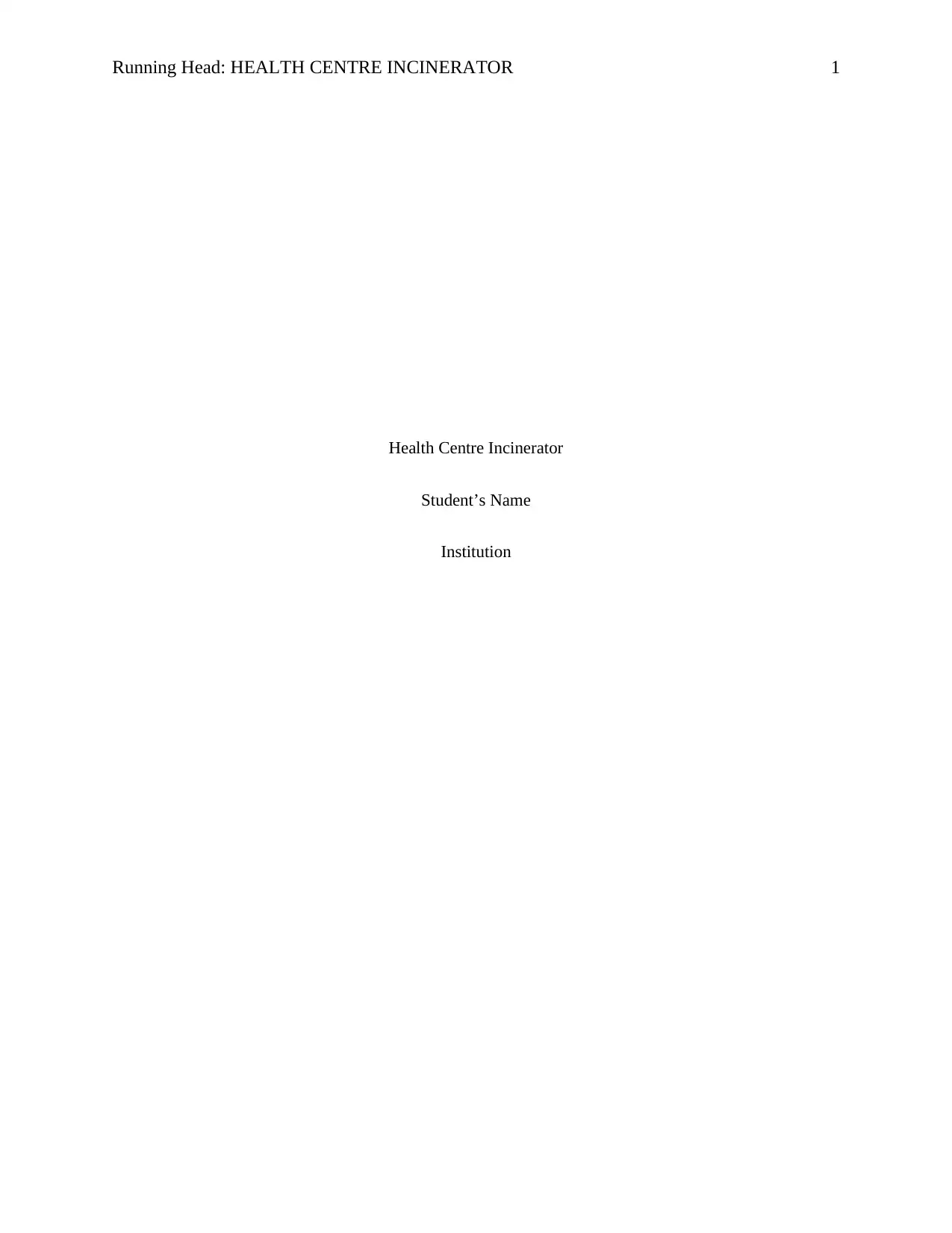
Running Head: HEALTH CENTRE INCINERATOR 1
Health Centre Incinerator
Student’s Name
Institution
Health Centre Incinerator
Student’s Name
Institution
Paraphrase This Document
Need a fresh take? Get an instant paraphrase of this document with our AI Paraphraser
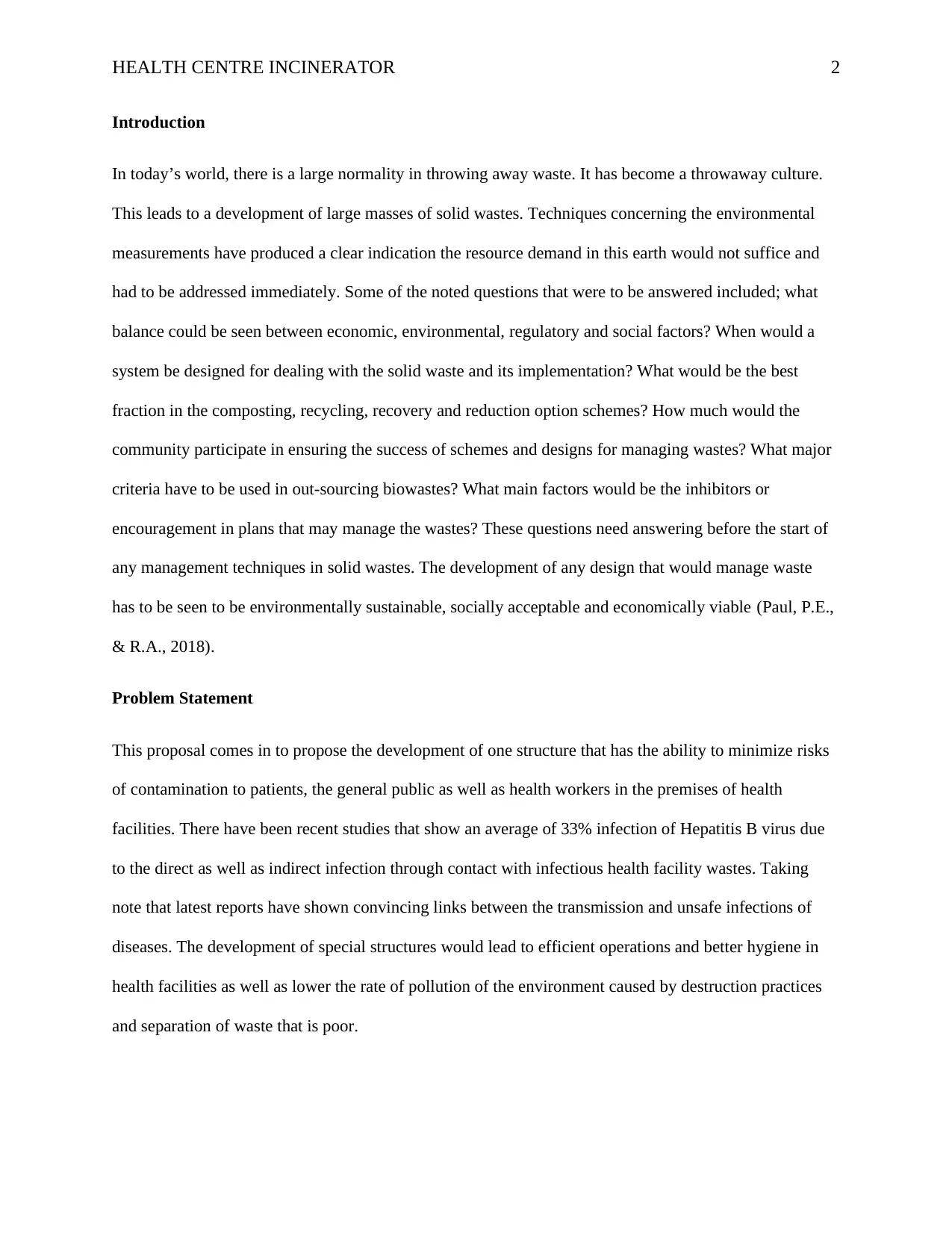
HEALTH CENTRE INCINERATOR 2
Introduction
In today’s world, there is a large normality in throwing away waste. It has become a throwaway culture.
This leads to a development of large masses of solid wastes. Techniques concerning the environmental
measurements have produced a clear indication the resource demand in this earth would not suffice and
had to be addressed immediately. Some of the noted questions that were to be answered included; what
balance could be seen between economic, environmental, regulatory and social factors? When would a
system be designed for dealing with the solid waste and its implementation? What would be the best
fraction in the composting, recycling, recovery and reduction option schemes? How much would the
community participate in ensuring the success of schemes and designs for managing wastes? What major
criteria have to be used in out-sourcing biowastes? What main factors would be the inhibitors or
encouragement in plans that may manage the wastes? These questions need answering before the start of
any management techniques in solid wastes. The development of any design that would manage waste
has to be seen to be environmentally sustainable, socially acceptable and economically viable (Paul, P.E.,
& R.A., 2018).
Problem Statement
This proposal comes in to propose the development of one structure that has the ability to minimize risks
of contamination to patients, the general public as well as health workers in the premises of health
facilities. There have been recent studies that show an average of 33% infection of Hepatitis B virus due
to the direct as well as indirect infection through contact with infectious health facility wastes. Taking
note that latest reports have shown convincing links between the transmission and unsafe infections of
diseases. The development of special structures would lead to efficient operations and better hygiene in
health facilities as well as lower the rate of pollution of the environment caused by destruction practices
and separation of waste that is poor.
Introduction
In today’s world, there is a large normality in throwing away waste. It has become a throwaway culture.
This leads to a development of large masses of solid wastes. Techniques concerning the environmental
measurements have produced a clear indication the resource demand in this earth would not suffice and
had to be addressed immediately. Some of the noted questions that were to be answered included; what
balance could be seen between economic, environmental, regulatory and social factors? When would a
system be designed for dealing with the solid waste and its implementation? What would be the best
fraction in the composting, recycling, recovery and reduction option schemes? How much would the
community participate in ensuring the success of schemes and designs for managing wastes? What major
criteria have to be used in out-sourcing biowastes? What main factors would be the inhibitors or
encouragement in plans that may manage the wastes? These questions need answering before the start of
any management techniques in solid wastes. The development of any design that would manage waste
has to be seen to be environmentally sustainable, socially acceptable and economically viable (Paul, P.E.,
& R.A., 2018).
Problem Statement
This proposal comes in to propose the development of one structure that has the ability to minimize risks
of contamination to patients, the general public as well as health workers in the premises of health
facilities. There have been recent studies that show an average of 33% infection of Hepatitis B virus due
to the direct as well as indirect infection through contact with infectious health facility wastes. Taking
note that latest reports have shown convincing links between the transmission and unsafe infections of
diseases. The development of special structures would lead to efficient operations and better hygiene in
health facilities as well as lower the rate of pollution of the environment caused by destruction practices
and separation of waste that is poor.
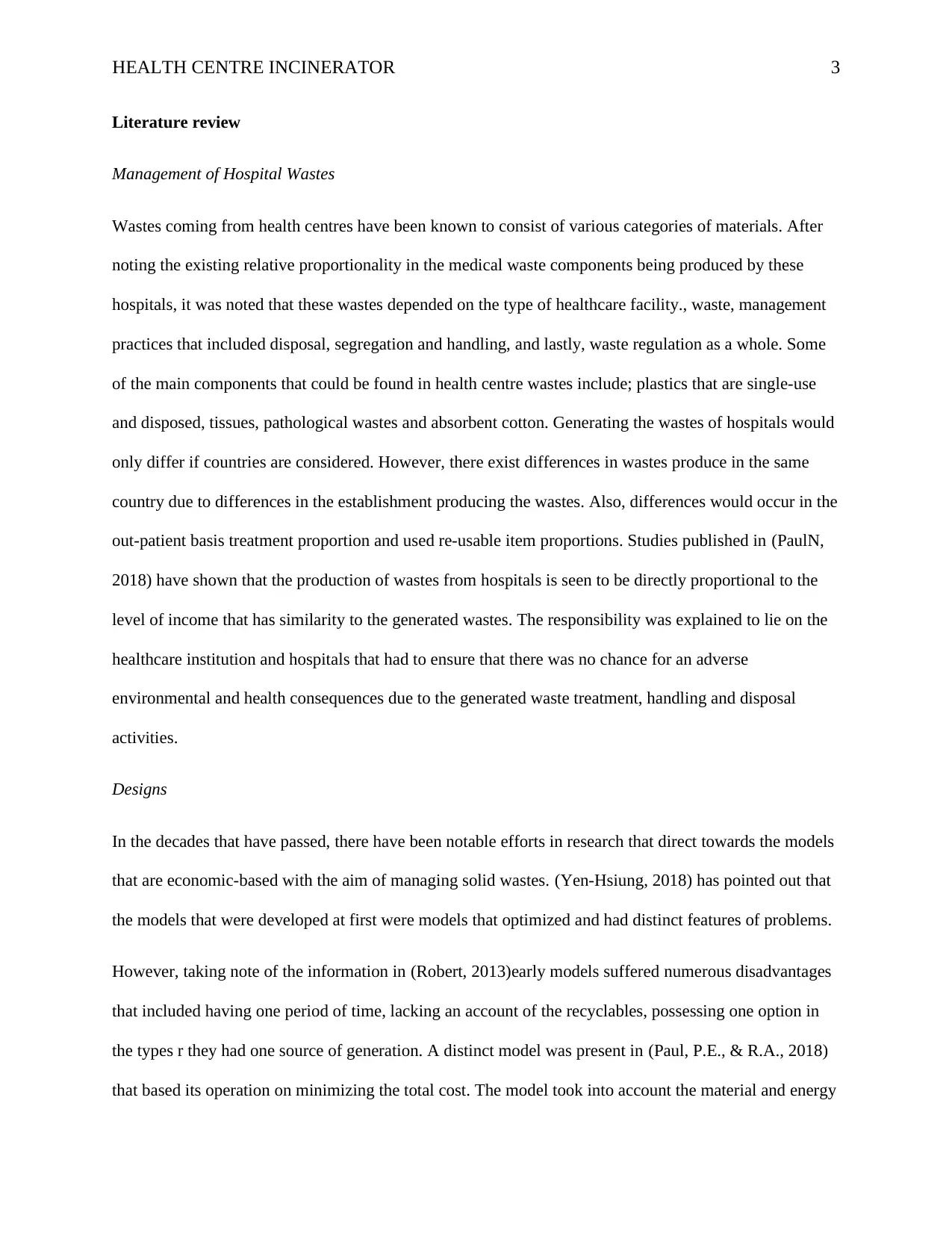
HEALTH CENTRE INCINERATOR 3
Literature review
Management of Hospital Wastes
Wastes coming from health centres have been known to consist of various categories of materials. After
noting the existing relative proportionality in the medical waste components being produced by these
hospitals, it was noted that these wastes depended on the type of healthcare facility., waste, management
practices that included disposal, segregation and handling, and lastly, waste regulation as a whole. Some
of the main components that could be found in health centre wastes include; plastics that are single-use
and disposed, tissues, pathological wastes and absorbent cotton. Generating the wastes of hospitals would
only differ if countries are considered. However, there exist differences in wastes produce in the same
country due to differences in the establishment producing the wastes. Also, differences would occur in the
out-patient basis treatment proportion and used re-usable item proportions. Studies published in (PaulN,
2018) have shown that the production of wastes from hospitals is seen to be directly proportional to the
level of income that has similarity to the generated wastes. The responsibility was explained to lie on the
healthcare institution and hospitals that had to ensure that there was no chance for an adverse
environmental and health consequences due to the generated waste treatment, handling and disposal
activities.
Designs
In the decades that have passed, there have been notable efforts in research that direct towards the models
that are economic-based with the aim of managing solid wastes. (Yen-Hsiung, 2018) has pointed out that
the models that were developed at first were models that optimized and had distinct features of problems.
However, taking note of the information in (Robert, 2013)early models suffered numerous disadvantages
that included having one period of time, lacking an account of the recyclables, possessing one option in
the types r they had one source of generation. A distinct model was present in (Paul, P.E., & R.A., 2018)
that based its operation on minimizing the total cost. The model took into account the material and energy
Literature review
Management of Hospital Wastes
Wastes coming from health centres have been known to consist of various categories of materials. After
noting the existing relative proportionality in the medical waste components being produced by these
hospitals, it was noted that these wastes depended on the type of healthcare facility., waste, management
practices that included disposal, segregation and handling, and lastly, waste regulation as a whole. Some
of the main components that could be found in health centre wastes include; plastics that are single-use
and disposed, tissues, pathological wastes and absorbent cotton. Generating the wastes of hospitals would
only differ if countries are considered. However, there exist differences in wastes produce in the same
country due to differences in the establishment producing the wastes. Also, differences would occur in the
out-patient basis treatment proportion and used re-usable item proportions. Studies published in (PaulN,
2018) have shown that the production of wastes from hospitals is seen to be directly proportional to the
level of income that has similarity to the generated wastes. The responsibility was explained to lie on the
healthcare institution and hospitals that had to ensure that there was no chance for an adverse
environmental and health consequences due to the generated waste treatment, handling and disposal
activities.
Designs
In the decades that have passed, there have been notable efforts in research that direct towards the models
that are economic-based with the aim of managing solid wastes. (Yen-Hsiung, 2018) has pointed out that
the models that were developed at first were models that optimized and had distinct features of problems.
However, taking note of the information in (Robert, 2013)early models suffered numerous disadvantages
that included having one period of time, lacking an account of the recyclables, possessing one option in
the types r they had one source of generation. A distinct model was present in (Paul, P.E., & R.A., 2018)
that based its operation on minimizing the total cost. The model took into account the material and energy
⊘ This is a preview!⊘
Do you want full access?
Subscribe today to unlock all pages.

Trusted by 1+ million students worldwide
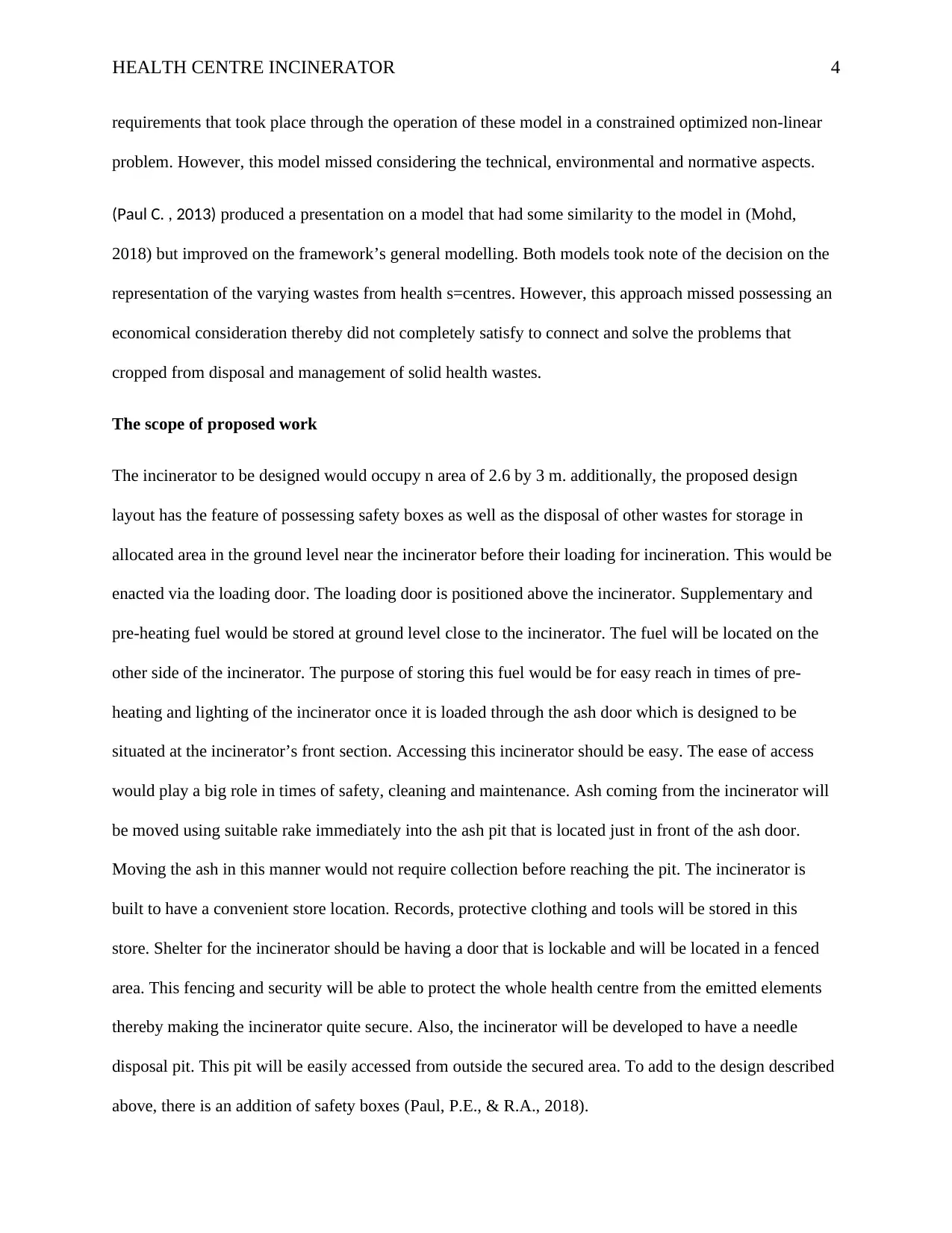
HEALTH CENTRE INCINERATOR 4
requirements that took place through the operation of these model in a constrained optimized non-linear
problem. However, this model missed considering the technical, environmental and normative aspects.
(Paul C. , 2013) produced a presentation on a model that had some similarity to the model in (Mohd,
2018) but improved on the framework’s general modelling. Both models took note of the decision on the
representation of the varying wastes from health s=centres. However, this approach missed possessing an
economical consideration thereby did not completely satisfy to connect and solve the problems that
cropped from disposal and management of solid health wastes.
The scope of proposed work
The incinerator to be designed would occupy n area of 2.6 by 3 m. additionally, the proposed design
layout has the feature of possessing safety boxes as well as the disposal of other wastes for storage in
allocated area in the ground level near the incinerator before their loading for incineration. This would be
enacted via the loading door. The loading door is positioned above the incinerator. Supplementary and
pre-heating fuel would be stored at ground level close to the incinerator. The fuel will be located on the
other side of the incinerator. The purpose of storing this fuel would be for easy reach in times of pre-
heating and lighting of the incinerator once it is loaded through the ash door which is designed to be
situated at the incinerator’s front section. Accessing this incinerator should be easy. The ease of access
would play a big role in times of safety, cleaning and maintenance. Ash coming from the incinerator will
be moved using suitable rake immediately into the ash pit that is located just in front of the ash door.
Moving the ash in this manner would not require collection before reaching the pit. The incinerator is
built to have a convenient store location. Records, protective clothing and tools will be stored in this
store. Shelter for the incinerator should be having a door that is lockable and will be located in a fenced
area. This fencing and security will be able to protect the whole health centre from the emitted elements
thereby making the incinerator quite secure. Also, the incinerator will be developed to have a needle
disposal pit. This pit will be easily accessed from outside the secured area. To add to the design described
above, there is an addition of safety boxes (Paul, P.E., & R.A., 2018).
requirements that took place through the operation of these model in a constrained optimized non-linear
problem. However, this model missed considering the technical, environmental and normative aspects.
(Paul C. , 2013) produced a presentation on a model that had some similarity to the model in (Mohd,
2018) but improved on the framework’s general modelling. Both models took note of the decision on the
representation of the varying wastes from health s=centres. However, this approach missed possessing an
economical consideration thereby did not completely satisfy to connect and solve the problems that
cropped from disposal and management of solid health wastes.
The scope of proposed work
The incinerator to be designed would occupy n area of 2.6 by 3 m. additionally, the proposed design
layout has the feature of possessing safety boxes as well as the disposal of other wastes for storage in
allocated area in the ground level near the incinerator before their loading for incineration. This would be
enacted via the loading door. The loading door is positioned above the incinerator. Supplementary and
pre-heating fuel would be stored at ground level close to the incinerator. The fuel will be located on the
other side of the incinerator. The purpose of storing this fuel would be for easy reach in times of pre-
heating and lighting of the incinerator once it is loaded through the ash door which is designed to be
situated at the incinerator’s front section. Accessing this incinerator should be easy. The ease of access
would play a big role in times of safety, cleaning and maintenance. Ash coming from the incinerator will
be moved using suitable rake immediately into the ash pit that is located just in front of the ash door.
Moving the ash in this manner would not require collection before reaching the pit. The incinerator is
built to have a convenient store location. Records, protective clothing and tools will be stored in this
store. Shelter for the incinerator should be having a door that is lockable and will be located in a fenced
area. This fencing and security will be able to protect the whole health centre from the emitted elements
thereby making the incinerator quite secure. Also, the incinerator will be developed to have a needle
disposal pit. This pit will be easily accessed from outside the secured area. To add to the design described
above, there is an addition of safety boxes (Paul, P.E., & R.A., 2018).
Paraphrase This Document
Need a fresh take? Get an instant paraphrase of this document with our AI Paraphraser
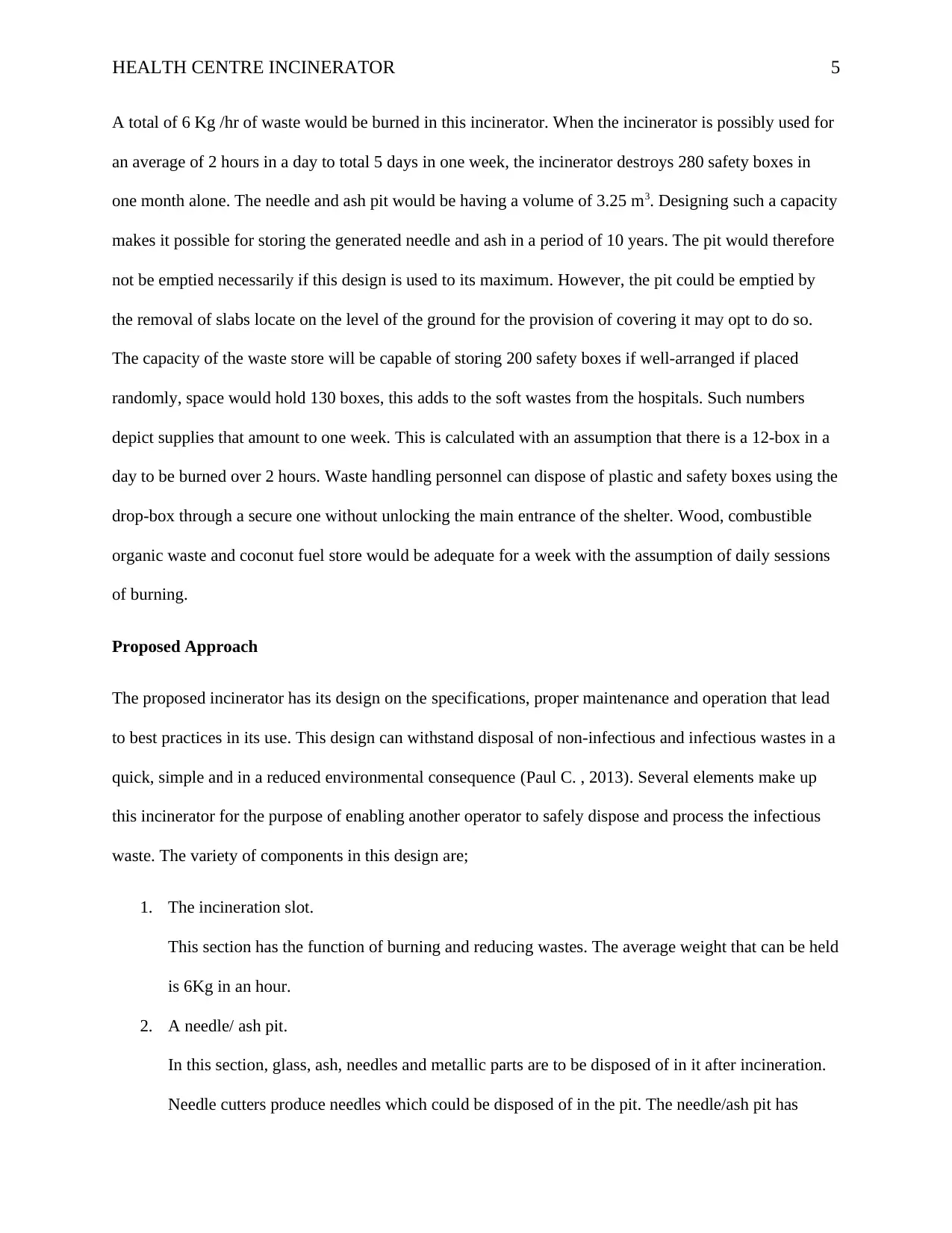
HEALTH CENTRE INCINERATOR 5
A total of 6 Kg /hr of waste would be burned in this incinerator. When the incinerator is possibly used for
an average of 2 hours in a day to total 5 days in one week, the incinerator destroys 280 safety boxes in
one month alone. The needle and ash pit would be having a volume of 3.25 m3. Designing such a capacity
makes it possible for storing the generated needle and ash in a period of 10 years. The pit would therefore
not be emptied necessarily if this design is used to its maximum. However, the pit could be emptied by
the removal of slabs locate on the level of the ground for the provision of covering it may opt to do so.
The capacity of the waste store will be capable of storing 200 safety boxes if well-arranged if placed
randomly, space would hold 130 boxes, this adds to the soft wastes from the hospitals. Such numbers
depict supplies that amount to one week. This is calculated with an assumption that there is a 12-box in a
day to be burned over 2 hours. Waste handling personnel can dispose of plastic and safety boxes using the
drop-box through a secure one without unlocking the main entrance of the shelter. Wood, combustible
organic waste and coconut fuel store would be adequate for a week with the assumption of daily sessions
of burning.
Proposed Approach
The proposed incinerator has its design on the specifications, proper maintenance and operation that lead
to best practices in its use. This design can withstand disposal of non-infectious and infectious wastes in a
quick, simple and in a reduced environmental consequence (Paul C. , 2013). Several elements make up
this incinerator for the purpose of enabling another operator to safely dispose and process the infectious
waste. The variety of components in this design are;
1. The incineration slot.
This section has the function of burning and reducing wastes. The average weight that can be held
is 6Kg in an hour.
2. A needle/ ash pit.
In this section, glass, ash, needles and metallic parts are to be disposed of in it after incineration.
Needle cutters produce needles which could be disposed of in the pit. The needle/ash pit has
A total of 6 Kg /hr of waste would be burned in this incinerator. When the incinerator is possibly used for
an average of 2 hours in a day to total 5 days in one week, the incinerator destroys 280 safety boxes in
one month alone. The needle and ash pit would be having a volume of 3.25 m3. Designing such a capacity
makes it possible for storing the generated needle and ash in a period of 10 years. The pit would therefore
not be emptied necessarily if this design is used to its maximum. However, the pit could be emptied by
the removal of slabs locate on the level of the ground for the provision of covering it may opt to do so.
The capacity of the waste store will be capable of storing 200 safety boxes if well-arranged if placed
randomly, space would hold 130 boxes, this adds to the soft wastes from the hospitals. Such numbers
depict supplies that amount to one week. This is calculated with an assumption that there is a 12-box in a
day to be burned over 2 hours. Waste handling personnel can dispose of plastic and safety boxes using the
drop-box through a secure one without unlocking the main entrance of the shelter. Wood, combustible
organic waste and coconut fuel store would be adequate for a week with the assumption of daily sessions
of burning.
Proposed Approach
The proposed incinerator has its design on the specifications, proper maintenance and operation that lead
to best practices in its use. This design can withstand disposal of non-infectious and infectious wastes in a
quick, simple and in a reduced environmental consequence (Paul C. , 2013). Several elements make up
this incinerator for the purpose of enabling another operator to safely dispose and process the infectious
waste. The variety of components in this design are;
1. The incineration slot.
This section has the function of burning and reducing wastes. The average weight that can be held
is 6Kg in an hour.
2. A needle/ ash pit.
In this section, glass, ash, needles and metallic parts are to be disposed of in it after incineration.
Needle cutters produce needles which could be disposed of in the pit. The needle/ash pit has
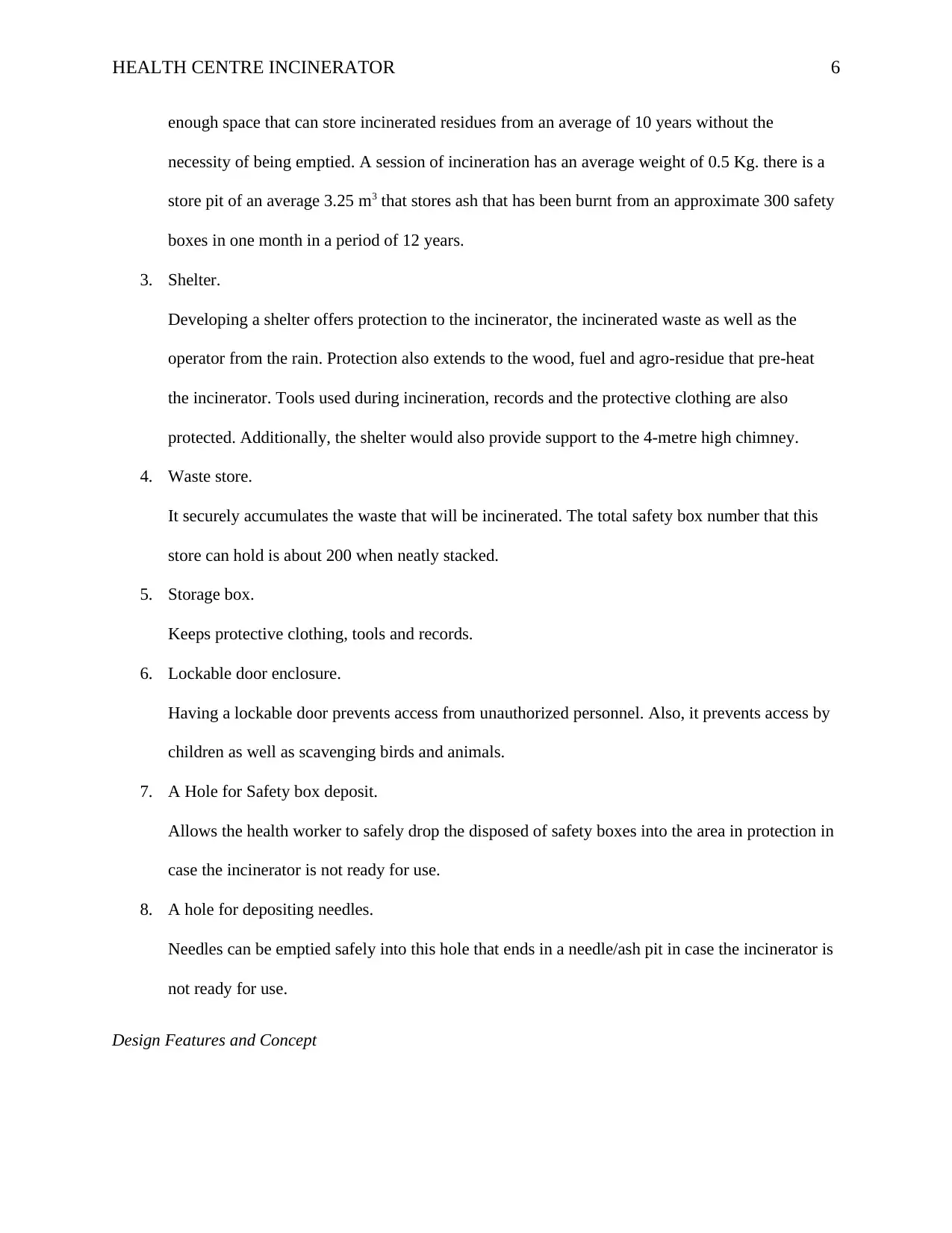
HEALTH CENTRE INCINERATOR 6
enough space that can store incinerated residues from an average of 10 years without the
necessity of being emptied. A session of incineration has an average weight of 0.5 Kg. there is a
store pit of an average 3.25 m3 that stores ash that has been burnt from an approximate 300 safety
boxes in one month in a period of 12 years.
3. Shelter.
Developing a shelter offers protection to the incinerator, the incinerated waste as well as the
operator from the rain. Protection also extends to the wood, fuel and agro-residue that pre-heat
the incinerator. Tools used during incineration, records and the protective clothing are also
protected. Additionally, the shelter would also provide support to the 4-metre high chimney.
4. Waste store.
It securely accumulates the waste that will be incinerated. The total safety box number that this
store can hold is about 200 when neatly stacked.
5. Storage box.
Keeps protective clothing, tools and records.
6. Lockable door enclosure.
Having a lockable door prevents access from unauthorized personnel. Also, it prevents access by
children as well as scavenging birds and animals.
7. A Hole for Safety box deposit.
Allows the health worker to safely drop the disposed of safety boxes into the area in protection in
case the incinerator is not ready for use.
8. A hole for depositing needles.
Needles can be emptied safely into this hole that ends in a needle/ash pit in case the incinerator is
not ready for use.
Design Features and Concept
enough space that can store incinerated residues from an average of 10 years without the
necessity of being emptied. A session of incineration has an average weight of 0.5 Kg. there is a
store pit of an average 3.25 m3 that stores ash that has been burnt from an approximate 300 safety
boxes in one month in a period of 12 years.
3. Shelter.
Developing a shelter offers protection to the incinerator, the incinerated waste as well as the
operator from the rain. Protection also extends to the wood, fuel and agro-residue that pre-heat
the incinerator. Tools used during incineration, records and the protective clothing are also
protected. Additionally, the shelter would also provide support to the 4-metre high chimney.
4. Waste store.
It securely accumulates the waste that will be incinerated. The total safety box number that this
store can hold is about 200 when neatly stacked.
5. Storage box.
Keeps protective clothing, tools and records.
6. Lockable door enclosure.
Having a lockable door prevents access from unauthorized personnel. Also, it prevents access by
children as well as scavenging birds and animals.
7. A Hole for Safety box deposit.
Allows the health worker to safely drop the disposed of safety boxes into the area in protection in
case the incinerator is not ready for use.
8. A hole for depositing needles.
Needles can be emptied safely into this hole that ends in a needle/ash pit in case the incinerator is
not ready for use.
Design Features and Concept
⊘ This is a preview!⊘
Do you want full access?
Subscribe today to unlock all pages.

Trusted by 1+ million students worldwide
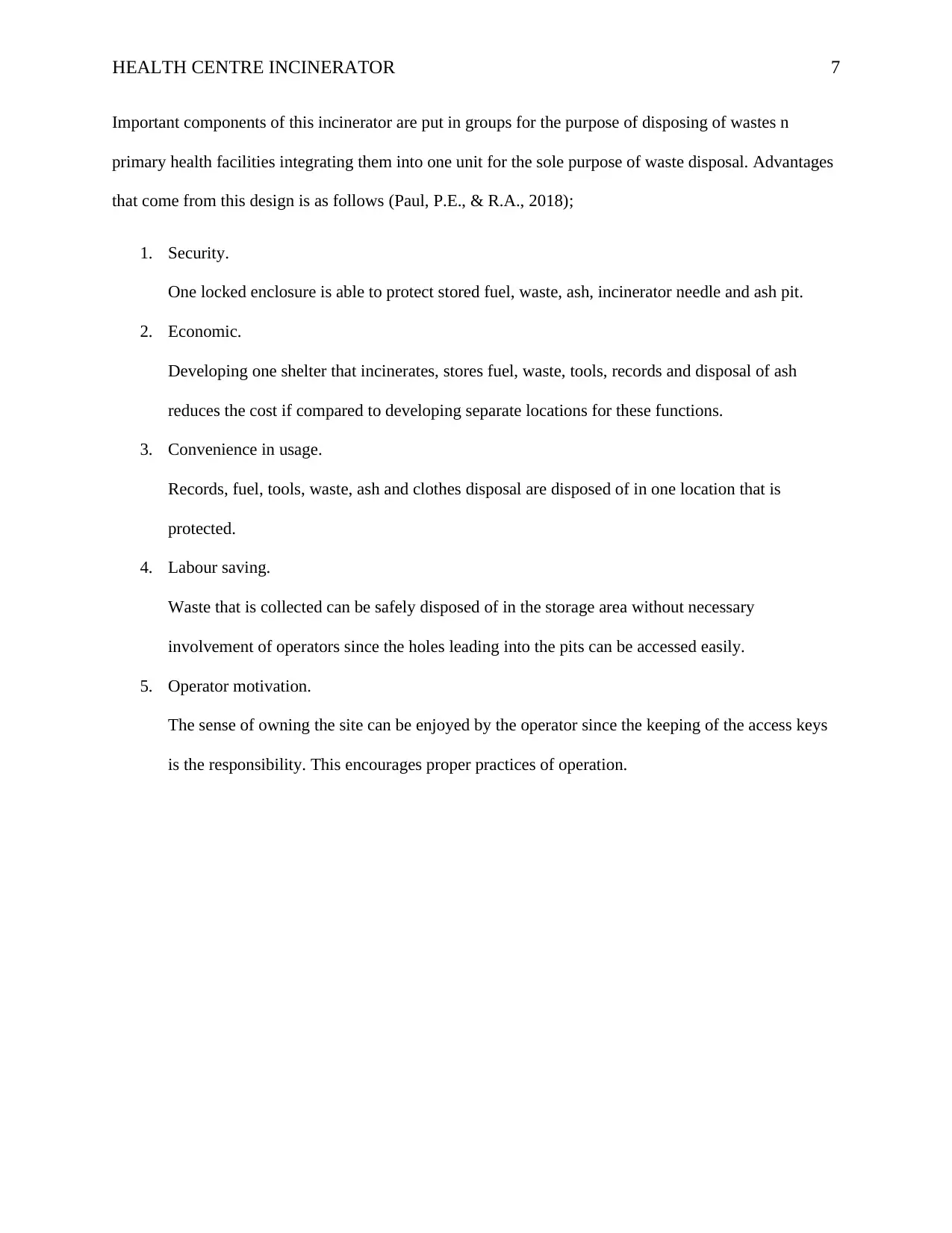
HEALTH CENTRE INCINERATOR 7
Important components of this incinerator are put in groups for the purpose of disposing of wastes n
primary health facilities integrating them into one unit for the sole purpose of waste disposal. Advantages
that come from this design is as follows (Paul, P.E., & R.A., 2018);
1. Security.
One locked enclosure is able to protect stored fuel, waste, ash, incinerator needle and ash pit.
2. Economic.
Developing one shelter that incinerates, stores fuel, waste, tools, records and disposal of ash
reduces the cost if compared to developing separate locations for these functions.
3. Convenience in usage.
Records, fuel, tools, waste, ash and clothes disposal are disposed of in one location that is
protected.
4. Labour saving.
Waste that is collected can be safely disposed of in the storage area without necessary
involvement of operators since the holes leading into the pits can be accessed easily.
5. Operator motivation.
The sense of owning the site can be enjoyed by the operator since the keeping of the access keys
is the responsibility. This encourages proper practices of operation.
Important components of this incinerator are put in groups for the purpose of disposing of wastes n
primary health facilities integrating them into one unit for the sole purpose of waste disposal. Advantages
that come from this design is as follows (Paul, P.E., & R.A., 2018);
1. Security.
One locked enclosure is able to protect stored fuel, waste, ash, incinerator needle and ash pit.
2. Economic.
Developing one shelter that incinerates, stores fuel, waste, tools, records and disposal of ash
reduces the cost if compared to developing separate locations for these functions.
3. Convenience in usage.
Records, fuel, tools, waste, ash and clothes disposal are disposed of in one location that is
protected.
4. Labour saving.
Waste that is collected can be safely disposed of in the storage area without necessary
involvement of operators since the holes leading into the pits can be accessed easily.
5. Operator motivation.
The sense of owning the site can be enjoyed by the operator since the keeping of the access keys
is the responsibility. This encourages proper practices of operation.
Paraphrase This Document
Need a fresh take? Get an instant paraphrase of this document with our AI Paraphraser
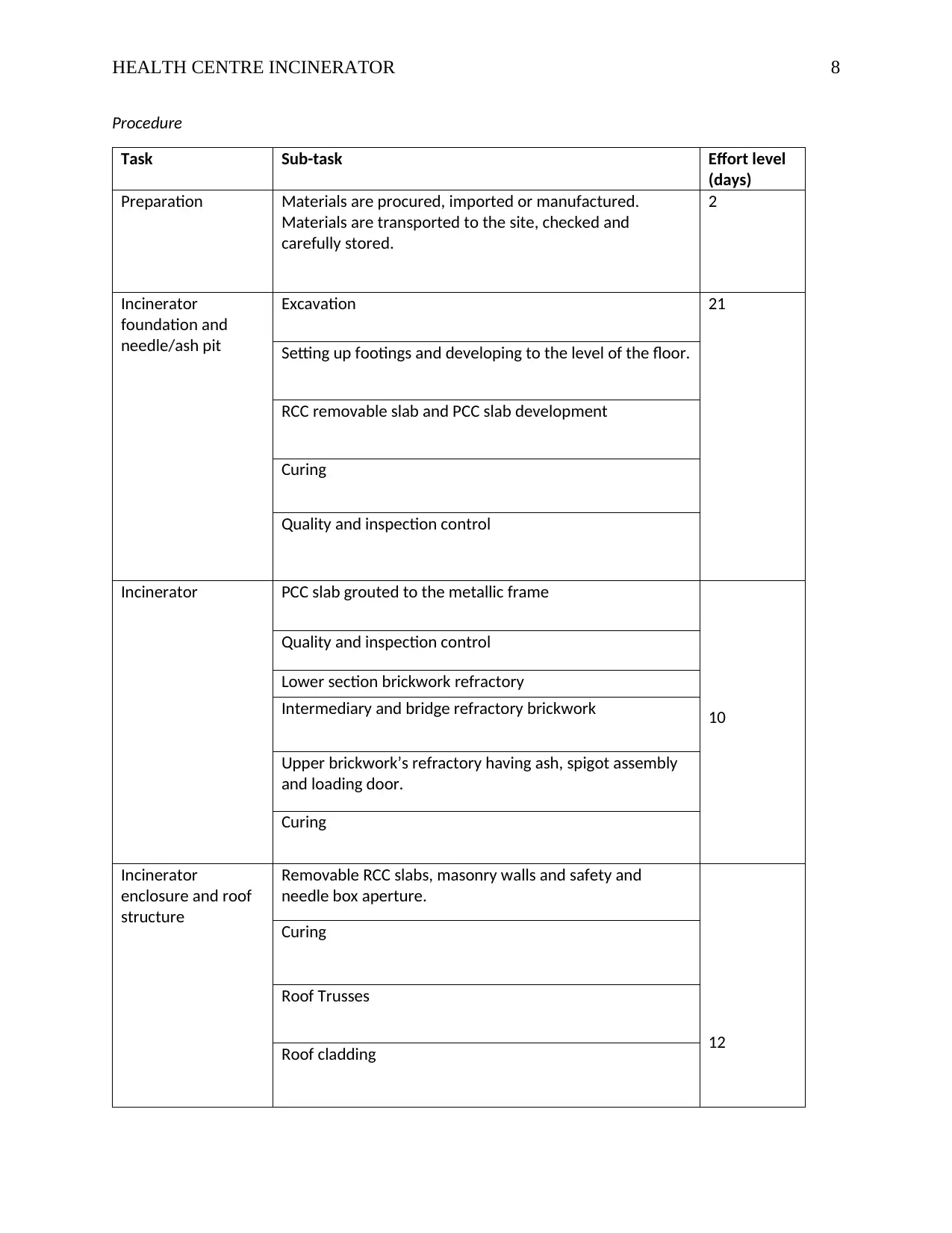
HEALTH CENTRE INCINERATOR 8
Procedure
Task Sub-task Effort level
(days)
Preparation Materials are procured, imported or manufactured.
Materials are transported to the site, checked and
carefully stored.
2
Incinerator
foundation and
needle/ash pit
Excavation 21
Setting up footings and developing to the level of the floor.
RCC removable slab and PCC slab development
Curing
Quality and inspection control
Incinerator PCC slab grouted to the metallic frame
10
Quality and inspection control
Lower section brickwork refractory
Intermediary and bridge refractory brickwork
Upper brickwork’s refractory having ash, spigot assembly
and loading door.
Curing
Incinerator
enclosure and roof
structure
Removable RCC slabs, masonry walls and safety and
needle box aperture.
12
Curing
Roof Trusses
Roof cladding
Procedure
Task Sub-task Effort level
(days)
Preparation Materials are procured, imported or manufactured.
Materials are transported to the site, checked and
carefully stored.
2
Incinerator
foundation and
needle/ash pit
Excavation 21
Setting up footings and developing to the level of the floor.
RCC removable slab and PCC slab development
Curing
Quality and inspection control
Incinerator PCC slab grouted to the metallic frame
10
Quality and inspection control
Lower section brickwork refractory
Intermediary and bridge refractory brickwork
Upper brickwork’s refractory having ash, spigot assembly
and loading door.
Curing
Incinerator
enclosure and roof
structure
Removable RCC slabs, masonry walls and safety and
needle box aperture.
12
Curing
Roof Trusses
Roof cladding
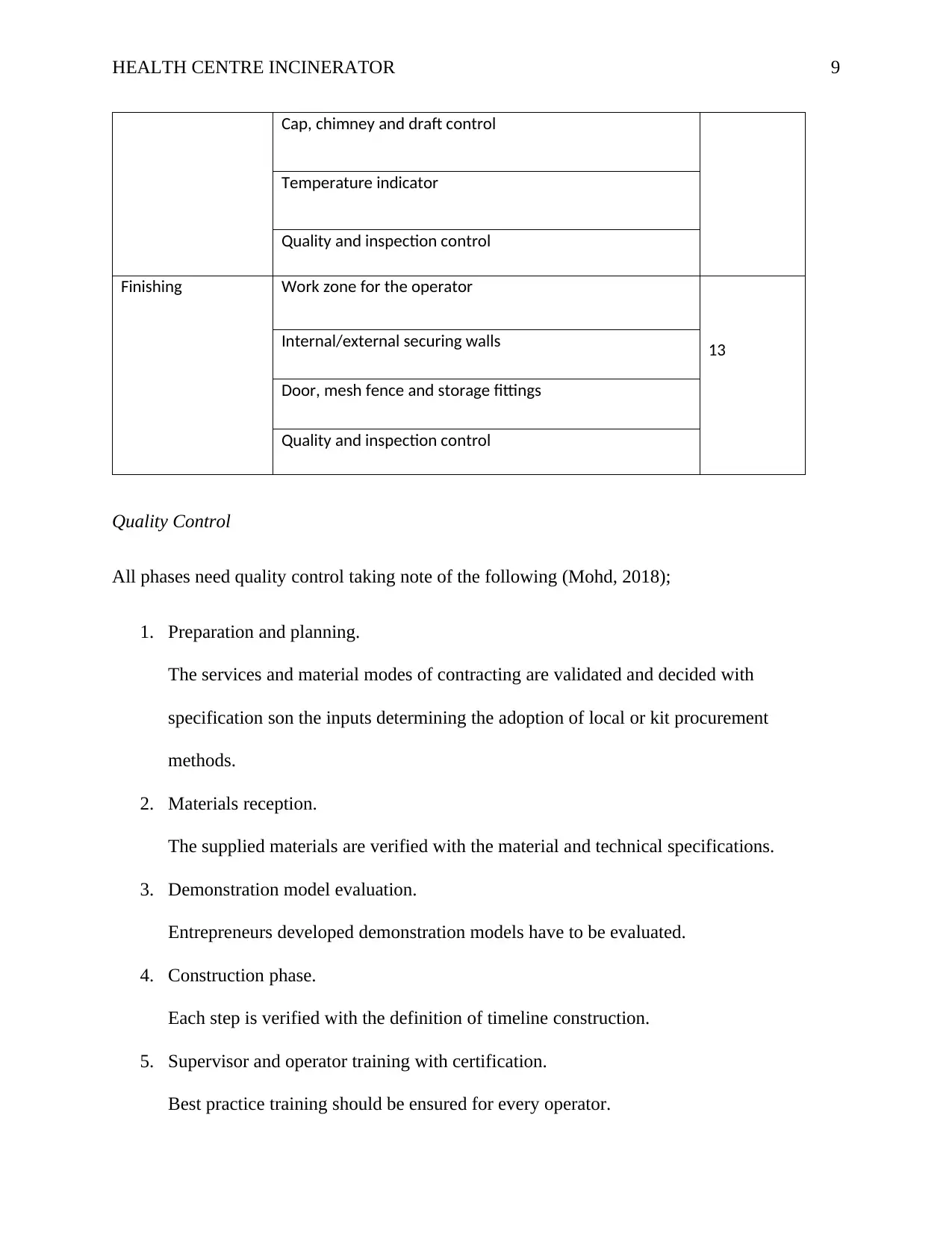
HEALTH CENTRE INCINERATOR 9
Cap, chimney and draft control
Temperature indicator
Quality and inspection control
Finishing Work zone for the operator
13
Internal/external securing walls
Door, mesh fence and storage fittings
Quality and inspection control
Quality Control
All phases need quality control taking note of the following (Mohd, 2018);
1. Preparation and planning.
The services and material modes of contracting are validated and decided with
specification son the inputs determining the adoption of local or kit procurement
methods.
2. Materials reception.
The supplied materials are verified with the material and technical specifications.
3. Demonstration model evaluation.
Entrepreneurs developed demonstration models have to be evaluated.
4. Construction phase.
Each step is verified with the definition of timeline construction.
5. Supervisor and operator training with certification.
Best practice training should be ensured for every operator.
Cap, chimney and draft control
Temperature indicator
Quality and inspection control
Finishing Work zone for the operator
13
Internal/external securing walls
Door, mesh fence and storage fittings
Quality and inspection control
Quality Control
All phases need quality control taking note of the following (Mohd, 2018);
1. Preparation and planning.
The services and material modes of contracting are validated and decided with
specification son the inputs determining the adoption of local or kit procurement
methods.
2. Materials reception.
The supplied materials are verified with the material and technical specifications.
3. Demonstration model evaluation.
Entrepreneurs developed demonstration models have to be evaluated.
4. Construction phase.
Each step is verified with the definition of timeline construction.
5. Supervisor and operator training with certification.
Best practice training should be ensured for every operator.
⊘ This is a preview!⊘
Do you want full access?
Subscribe today to unlock all pages.

Trusted by 1+ million students worldwide
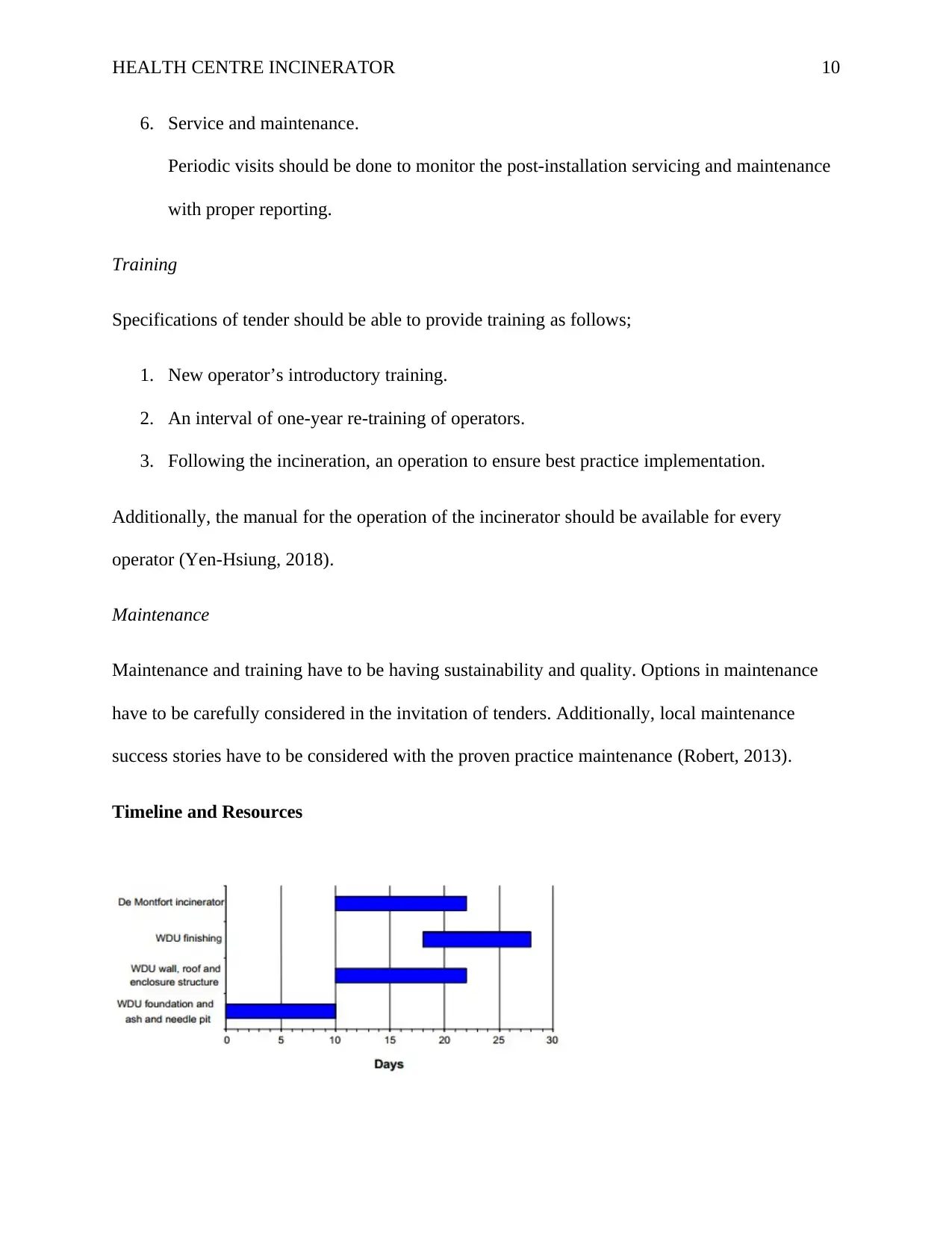
HEALTH CENTRE INCINERATOR 10
6. Service and maintenance.
Periodic visits should be done to monitor the post-installation servicing and maintenance
with proper reporting.
Training
Specifications of tender should be able to provide training as follows;
1. New operator’s introductory training.
2. An interval of one-year re-training of operators.
3. Following the incineration, an operation to ensure best practice implementation.
Additionally, the manual for the operation of the incinerator should be available for every
operator (Yen-Hsiung, 2018).
Maintenance
Maintenance and training have to be having sustainability and quality. Options in maintenance
have to be carefully considered in the invitation of tenders. Additionally, local maintenance
success stories have to be considered with the proven practice maintenance (Robert, 2013).
Timeline and Resources
6. Service and maintenance.
Periodic visits should be done to monitor the post-installation servicing and maintenance
with proper reporting.
Training
Specifications of tender should be able to provide training as follows;
1. New operator’s introductory training.
2. An interval of one-year re-training of operators.
3. Following the incineration, an operation to ensure best practice implementation.
Additionally, the manual for the operation of the incinerator should be available for every
operator (Yen-Hsiung, 2018).
Maintenance
Maintenance and training have to be having sustainability and quality. Options in maintenance
have to be carefully considered in the invitation of tenders. Additionally, local maintenance
success stories have to be considered with the proven practice maintenance (Robert, 2013).
Timeline and Resources
Paraphrase This Document
Need a fresh take? Get an instant paraphrase of this document with our AI Paraphraser
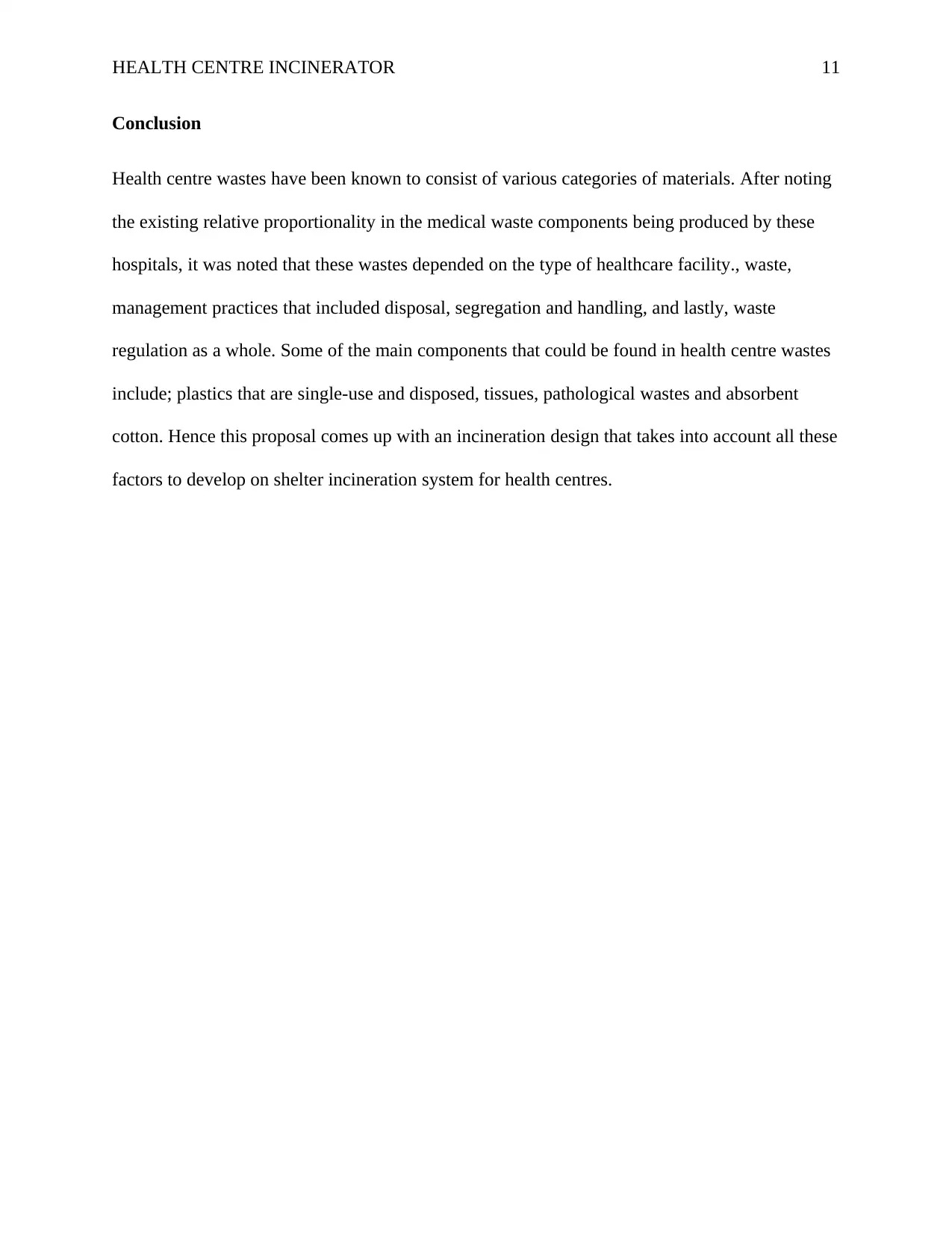
HEALTH CENTRE INCINERATOR 11
Conclusion
Health centre wastes have been known to consist of various categories of materials. After noting
the existing relative proportionality in the medical waste components being produced by these
hospitals, it was noted that these wastes depended on the type of healthcare facility., waste,
management practices that included disposal, segregation and handling, and lastly, waste
regulation as a whole. Some of the main components that could be found in health centre wastes
include; plastics that are single-use and disposed, tissues, pathological wastes and absorbent
cotton. Hence this proposal comes up with an incineration design that takes into account all these
factors to develop on shelter incineration system for health centres.
Conclusion
Health centre wastes have been known to consist of various categories of materials. After noting
the existing relative proportionality in the medical waste components being produced by these
hospitals, it was noted that these wastes depended on the type of healthcare facility., waste,
management practices that included disposal, segregation and handling, and lastly, waste
regulation as a whole. Some of the main components that could be found in health centre wastes
include; plastics that are single-use and disposed, tissues, pathological wastes and absorbent
cotton. Hence this proposal comes up with an incineration design that takes into account all these
factors to develop on shelter incineration system for health centres.
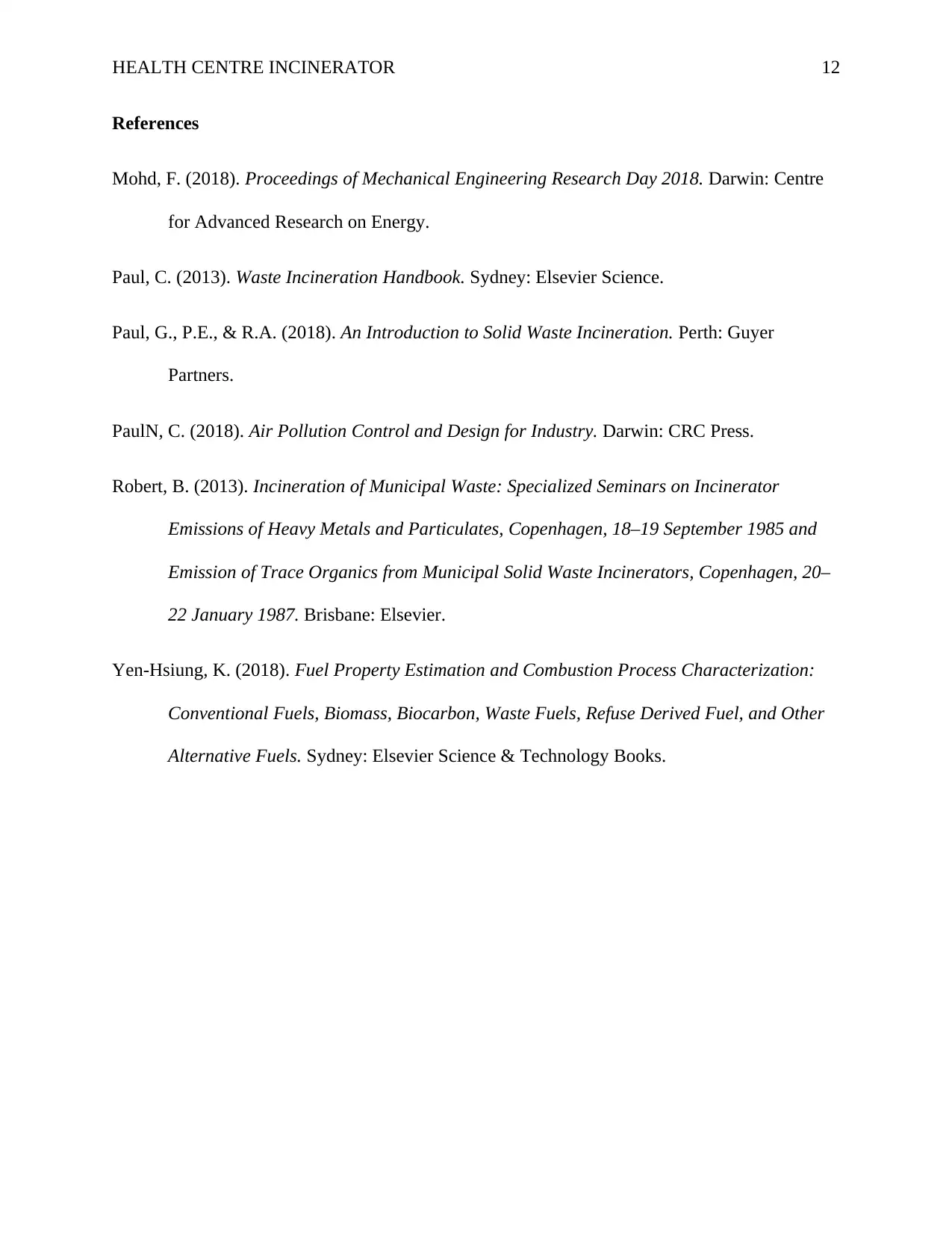
HEALTH CENTRE INCINERATOR 12
References
Mohd, F. (2018). Proceedings of Mechanical Engineering Research Day 2018. Darwin: Centre
for Advanced Research on Energy.
Paul, C. (2013). Waste Incineration Handbook. Sydney: Elsevier Science.
Paul, G., P.E., & R.A. (2018). An Introduction to Solid Waste Incineration. Perth: Guyer
Partners.
PaulN, C. (2018). Air Pollution Control and Design for Industry. Darwin: CRC Press.
Robert, B. (2013). Incineration of Municipal Waste: Specialized Seminars on Incinerator
Emissions of Heavy Metals and Particulates, Copenhagen, 18–19 September 1985 and
Emission of Trace Organics from Municipal Solid Waste Incinerators, Copenhagen, 20–
22 January 1987. Brisbane: Elsevier.
Yen-Hsiung, K. (2018). Fuel Property Estimation and Combustion Process Characterization:
Conventional Fuels, Biomass, Biocarbon, Waste Fuels, Refuse Derived Fuel, and Other
Alternative Fuels. Sydney: Elsevier Science & Technology Books.
References
Mohd, F. (2018). Proceedings of Mechanical Engineering Research Day 2018. Darwin: Centre
for Advanced Research on Energy.
Paul, C. (2013). Waste Incineration Handbook. Sydney: Elsevier Science.
Paul, G., P.E., & R.A. (2018). An Introduction to Solid Waste Incineration. Perth: Guyer
Partners.
PaulN, C. (2018). Air Pollution Control and Design for Industry. Darwin: CRC Press.
Robert, B. (2013). Incineration of Municipal Waste: Specialized Seminars on Incinerator
Emissions of Heavy Metals and Particulates, Copenhagen, 18–19 September 1985 and
Emission of Trace Organics from Municipal Solid Waste Incinerators, Copenhagen, 20–
22 January 1987. Brisbane: Elsevier.
Yen-Hsiung, K. (2018). Fuel Property Estimation and Combustion Process Characterization:
Conventional Fuels, Biomass, Biocarbon, Waste Fuels, Refuse Derived Fuel, and Other
Alternative Fuels. Sydney: Elsevier Science & Technology Books.
⊘ This is a preview!⊘
Do you want full access?
Subscribe today to unlock all pages.

Trusted by 1+ million students worldwide
1 out of 12
Related Documents
Your All-in-One AI-Powered Toolkit for Academic Success.
+13062052269
info@desklib.com
Available 24*7 on WhatsApp / Email
![[object Object]](/_next/static/media/star-bottom.7253800d.svg)
Unlock your academic potential
Copyright © 2020–2025 A2Z Services. All Rights Reserved. Developed and managed by ZUCOL.





